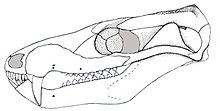| Brasilodon Temporal range: Late Triassic
~ | |
|---|---|

| |
| Reconstructed skull in lateral view | |
| Scientific classification | |
| Domain: | Eukaryota |
| Kingdom: | Animalia |
| Phylum: | Chordata |
| Clade: | Synapsida |
| Clade: | Therapsida |
| Clade: | Cynodontia |
| Clade: | Mammaliamorpha |
| Family: | †Brasilodontidae Bonaparte et al., 2005 |
| Genus: | †Brasilodon Bonaparte et al., 2003 |
| Species: | †B. quadrangularis
|
| Binomial name | |
| †Brasilodon quadrangularis Bonaparte et al., 2003
| |
| Synonyms | |
| |
Brasilodon ("tooth from Brazil") is an extinct genus of small, mammal-like cynodonts that lived in what is now Brazil during the Norian age of the Late Triassic epoch, about 225.42 million years ago. While no complete skeletons have been found, the length of Brasilodon has been estimated at 12 centimetres (4.7 in). Its dentition shows that it was most likely an insectivore. The genus is monotypic, containing only the species B. quadrangularis. Brasilodon belongs to the family Brasilodontidae, whose members were some of the closest relatives of mammals, the only cynodonts alive today. Two other brasilodontid genera, Brasilitherium and Minicynodon, are now considered to be junior synonyms of Brasilodon.